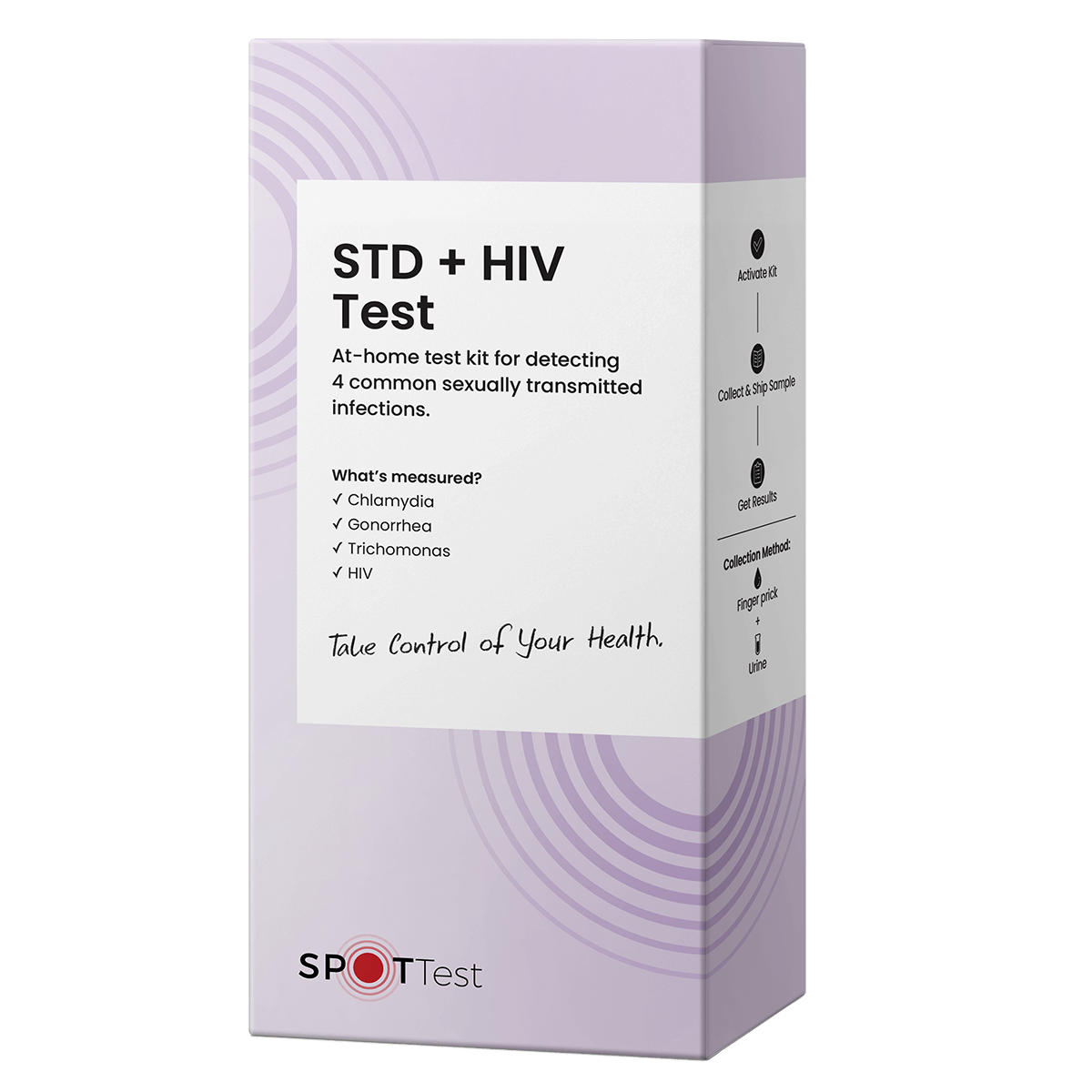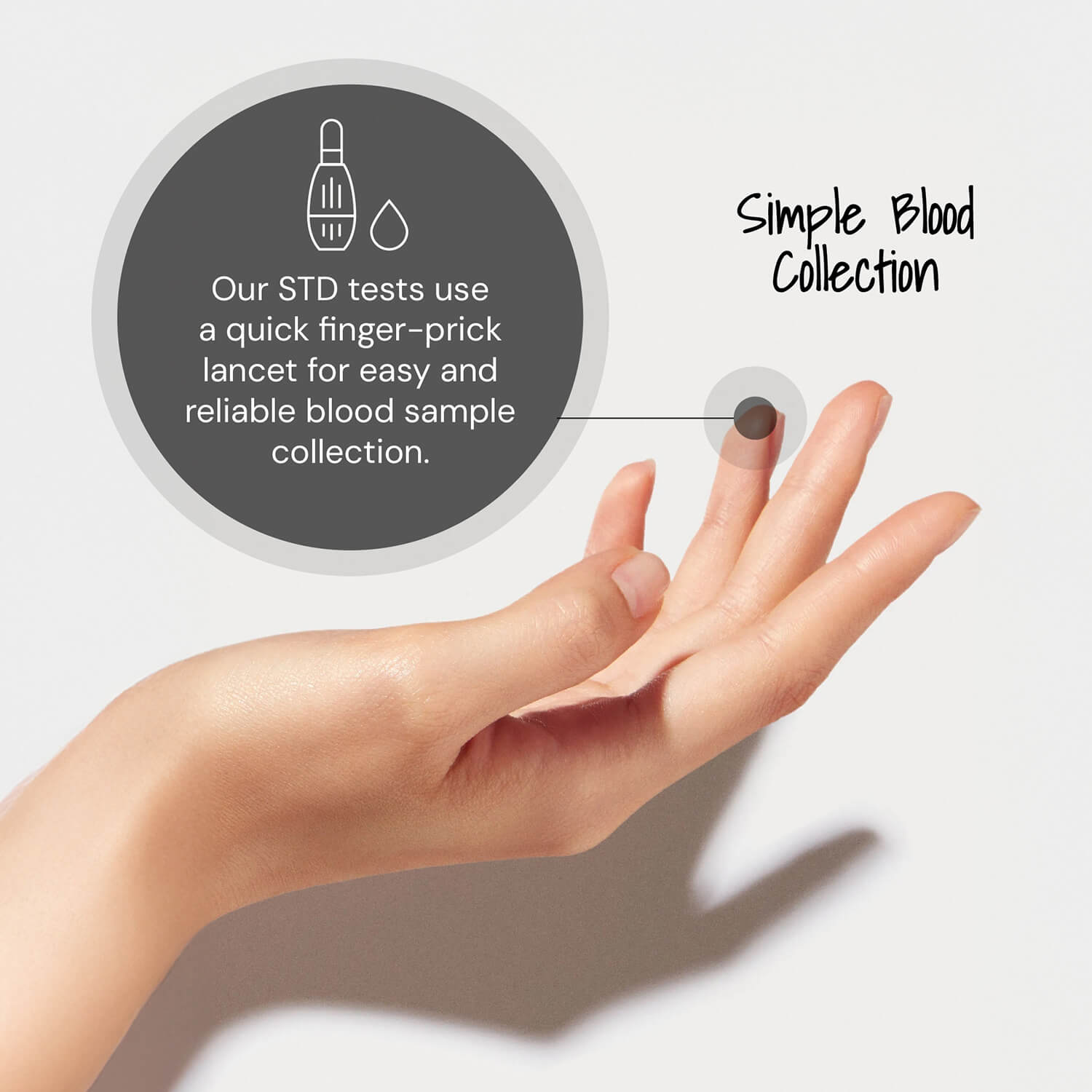STD & HIV Test
Convenient at-home test to check for 4 common sexually transmitted diseases (STDs). Fast, easy-to-read, and discreet results.
Measures:
✓ Chlamydia
✓ Gonorrhea
✓ Trichomoniasis
✓ HIV
Collection methods:
Finger Prick Blood & Urine
$149.00 Original price was: $149.00.$99.00Current price is: $99.00.
- Highest accuracy
- Discreet shipping
- Results in 1-3 days*
- Highest accuracy
- Discreet
- Results in 1-3 business days
STDs can be quickly diagnosed and are often easily treatable too
Sexually transmitted diseases (STDs), also called sexually transmitted infections (STIs), are infections typically spread through vaginal, anal, or oral sex. Many STDs are common, but many infected individuals may not show symptoms and unknowingly pass the infection to others. If left untreated, STDs can lead to serious health complications. Fortunately, most STDs are easy to test for and treat. Take control of your health—get tested today from the privacy of your home.

Why consider this test?
You should consider getting tested if:
- You are sexually active
- You have had unprotected sex
- You are entering a new relationship
- You are experiencing symptoms of an STD
- You have had a partner with an STD
If you suspect that you have been exposed to an STD, be aware that there is a “window period” where laboratory assays are unable to detect the STD. This period differs for each STD. Most STDs can be detected with 2 to 4 weeks post-exposure, while others (such as hepatitis C and syphilis) may not be detectable until 10-12 weeks post-exposure.
SYMPTOMS of
Symptoms of STDs
Pain and burning while urinating
Rectal pain, swelling or discharge
Abnormal discharge
Bleeding after sex
Itching or burning of the genitals and/or anus
Rash in the genital area or anus
What's included in this test?
Chlamydia is an STD caused by the bacteria Chlamydia trachomatis. It’s the most commonly reported bacterial infection worldwide. Approximately 60% of new chlamydia infections occur in individuals aged between 15 and 24 years, with reported chlamydia rates in females being approximately two times the rate among males.
Chlamydia is diagnosed by nucleic acid amplification testing of vaginal swabs or urine specimens. Fortunately, chlamydia can be effectively treated with antibiotics. However, reinfections can occur through sexual contact with an infected partner, posing a risk of serious reproductive health complications.
Gonorrhea is another common STD caused by the bacteria Neisseria gonorrhoeae. In women, this infection can impact the cervix, uterus, and fallopian tubes, while in men, it primarily affects the urethra. It can also infect the mucous membranes of the mouth, eyes, and rectum.
Gonorrhea is typically diagnosed through nucleic acid amplification testing of vaginal swabs or urine samples. Gonorrhea is curable with dual antibiotic therapy. However, similar to chlamydia, repeat infections are common following sexual contact with an infected partner, increasing the risk of serious reproductive health complications.
Trichomoniasis is caused by a protozoan parasite called Trichomonas vaginalis. Infections occur in the lower genital tract, vulva, vagina, cervix, and urethra of women. The inside of the penis (urethra) is the most commonly infected body part of men. Most individuals infected with trichomoniasis remain asymptomatic, with only approximately 30% of infected individuals showing symptoms.
Trichomoniasis is diagnosed by nucleic acid amplification testing of vaginal swabs or urine specimens. It is easily cured with antibiotics; however reinfections can occur after treatment through subsequent sexual contact with an infected partner.
HIV is a sexually transmitted infection caused by the human immunodeficiency virus (HIV). When left untreated, an HIV infection can lead to acquired human immunodeficiency syndrome or AIDS. As HIV attacks the immune system, individuals with AIDS have impaired immunity and are highly susceptible to infections.
How It Works


CHOOSE TEST
Select your test from our wide selection of home test kit options. Receive your kit within a few days in a discreet unmarked package.

COLLECT SAMPLE
Collect your sample quickly and discreetly from the privacy of your own home. No appointments or lab visits required.

GET YOUR RESULTS
Get your physician reviewed results in a secure online portal in 1-2 days. Free telehealth consult provided if required.

FAQs
For more, visit our Learning Center

Chlamydia, Gonorrhea & Trichomoniasis
Collect a urine sample using the provided cup and transfer it into the sample vial. Mail this to our lab using the prepaid envelope. At the laboratory, we use a highly-sensitive molecular testing technique known as nucleic acid amplification testing (NAAT), that detects the presence of bacterial DNA. NAAT tests are the most sensitive and can be performed rapidly.
HIV
Collect a fingerprick blood sample using the blood spot collection card provided in the kit. Mail the kit to our lab using the prepaid envelope. Our lab uses a fully automated antigen/antibody combination test to detect the presence of the HIV p24 antigen and antibodies to HIV-1 and HIV-2 in the finger prick blood sample. The p24 antigen is usually detected within 2-3 weeks post-exposure, while HIV antibodies are generally detected 4-6 weeks post-exposure.
If you receive a positive result, contact a healthcare professional immediately to start treatment. Follow your healthcare provider’s treatment recommendations and inform your sexual partners so they can also get tested and treated if necessary.
Chlamydia, Gonorrhea, and Trichomoniasis
These infections are commonly treated with antibiotics. The specific type and length of antibiotic treatment can vary depending on the individual and the severity of the infection. It’s important for both the infected individual and their sexual partners to undergo treatment to prevent re-infection, and they should abstain from sexual activity until the infection is fully resolved.
Human Immunodeficiency Virus (HIV)
While there is currently no cure for HIV, it can be effectively managed with a lifelong regimen of antiretroviral therapy (ART). ART doesn’t cure HIV but can helps significantly reduce the virus’s impact on the body and prevents its transmission. People living with HIV need to adhere strictly to their treatment plan and have regular medical check-ups to monitor their health.
Early diagnosis and consistent adherence to treatment are essential for effectively managing these infections. Please note that these are general guidelines, and the specific treatment for an individual will depend on their overall health, the stage of the disease, and other factors. Therefore, it’s important to consult with a healthcare provider for personalized advice. Also, remember to complete the entire course of prescribed medication, even if symptoms improve before finishing the treatment.
To reduce your risk of contracting these STDs, consider the following preventive measures:
- Practice Abstinence: The surest way to prevent these STDs is to abstain from or delay sexual activity.
- Get Regularly Tested: Regular testing is especially important if you have multiple partners or engage in high-risk behaviors. Early detection through tests can lead to timely treatment.
- Use Condoms Correctly: Condoms are effective in reducing the risk of STD transmission when used properly during every sexual encounter.
- Limit Sexual Partners: Reducing the number of sexual partners can decrease your risk of exposure to STDs.
- Mutual Monogamy: Being in a mutually monogamous relationship where both partners have been tested and know their STD status can significantly reduce risk.
- Pre-exposure Prophylaxis (PrEP): If you are at high risk for HIV, PrEP is a daily medication that can greatly reduce your risk of HIV infection.
- Post-exposure Prophylaxis (PEP): If you think you’ve been exposed to HIV within the last 72 hours, PEP can reduce your risk of becoming HIV-positive.
- Avoid Sharing Needles: Never share needles, syringes, or other injecting equipment.
Chlamydia, gonorrhea, trichomoniasis and HIV are quite prevalent in the United States:
- Chlamydia: In 2021, there were 1.6 million reported chlamydia cases, marking a 4.1% increase from 2020.
- Gonorrhea: More than 700,000 cases were reported in 2021, a 28% increase since 2017.
- Trichomoniasis: There were an estimated 2.6 million infections in 2018, with a prevalence of 2.1% among women aged 14-59 and 0.5% among men, according to a 2013-2016 survey.
- HIV: Approximately 32,100 new HIV infections occurred in the United States in 2021. An estimated 1.2 million people in the U.S. were living with HIV, with about 87% aware of their status.
These statistics underscore the importance of regular testing for sexually transmitted infections, including HIV, as part of routine healthcare.
A negative result does not completely exclude the possibility of an infection. False-negative results might occur if the test is taken too early after exposure (aka during the “window period”), as the organism levels might be below the sensitivity of the assay. Improper specimen collection can impact the accuracy of the test. Concurrent antibiotic therapy might suppress the detectable level of the causative organism, leading to a false-negative. The presence of inhibitors in the test sample can also interfere with the accurate detection of the organism.
False-positive results, although rare, are still possible. They may occur shortly after successful antimicrobial therapy for chlamydia, gonorrhea, and trichomoniasis, as the test might still detect remnants of the organisms





